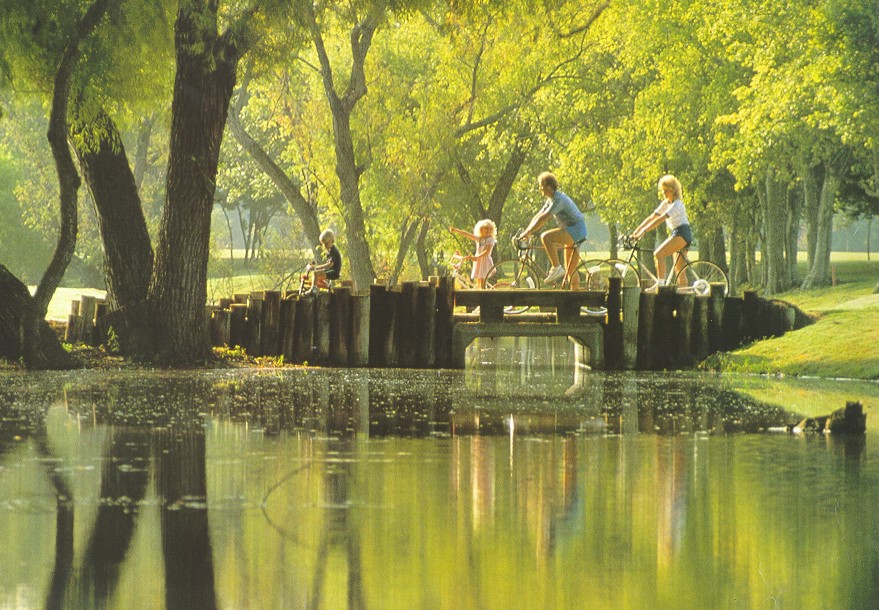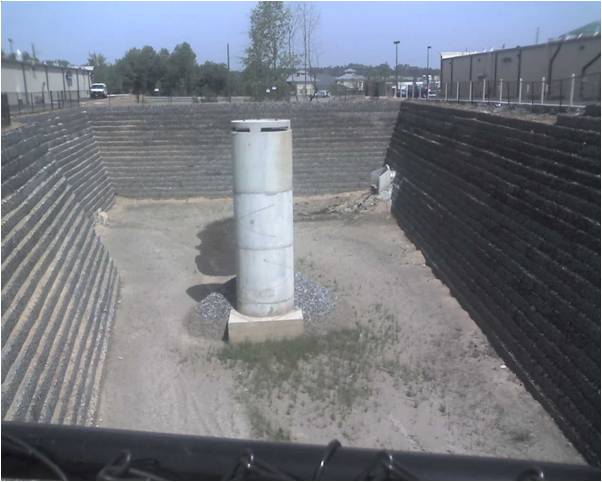By Jonathan E. Jones, P.E., D.WRE; A. Charles Rowney, Ph.D., P.Eng.; and Ben Urbonas, P.E. D.WRE
It is impractical, if not impossible, to provide zero risk at stormwater management facilities. Like other types of public works infrastructure, there are inherent risks associated with conveying, storing, treating, and otherwise managing stormwater.
Potential hazards to the public can be apparent, as shown in the images on the left, but can also be far more subtle and not easily recognizable. In February 2011, two teenage boys drowned in Walnut Creek in Northern California. As reported in the San Francisco Chronicle, the channel was only a few feet deep, but its appearance was deceiving. The teens, attempting to raft the waterway after a heavy rainstorm, put in on private property where the local government apparently had little control over protective measures and signage. A short distance from their launch point, the creek entered a concrete channel with 6-m-high (20-ft-high) walls designed decades ago to drain stormwater. The channel ran through an underground tunnel and into a stormwater pond.
While natural waterbodies also pose risks, many hazards at stormwater facilities can be anticipated, discussed with relevant public and private parties, evaluated, and mitigated where appropriate. Public discourse and education on the purpose of stormwater facilities and their potential danger is valuable.
Led by the American Society of Civil Engineers (ASCE) Environmental & Water Resources Institute (EWRI), approximately 80 members of various water and engineering associations are coordinating on a report titled Guidance for Protection of Public Safety at Urban Stormwater Management Facilities.* The guidance document, to be released late this year, covers the planning, design, operation, and maintenance of stormwater facilities, including ponds, channels, small dams, water quality best management practices, and green infrastructure features. The intended audience includes engineers, landscape architects, land planners, and other stormwater professionals.
While based on the guidance document, this article does not capture its full content. Interested readers are encouraged to obtain the final document for a more comprehensive treatment of the subject.
Design

This stormwater retention pond has good safety characteristics, including mild, well-vegetated side slopes and a gentle drop-off below the water level. It has trails safe for public use, regular maintenance, and attractive appearance.
Credit: Donald Brandes, RLA
Many safety concerns can be mitigated through proper design. As in the Walnut Creek accident described above, pond and channel side slopes that are overly steep can make escape difficult and impede access by maintenance crews or emergency personnel. As shown in the image to the right, mild slopes leading to the edges of channels, ponds, and other facilities make falling in less likely and escape easier.
Planning facilities that are visible can help minimize incidental contact with stormwater and high flows. In addition, mild slopes and visible facilities are more accessible to emergency personnel. Furthermore, communities should have trained emergency response staff who are familiar with the special conditions posed by flowing and rising water during storm events.
Inlet racks designed to prevent trash and debris from entering culverts can also prevent people, including children, from entering underground pipes that can contain insects, chemicals, or other hazards. However, fast-moving water can pin people against these racks unless they are oversized and positioned in front of the culverts or pipe entrances in ways that reduce these risks.
People swept into long pipes could be trapped and submerged for minutes, as well as battered during transit, with fatal results. Long pipes and racks should be considered on a case-by-case basis and evaluated for safety during design.
Small dams on streams or rivers, weirs, and grade-control structures can create currents that are difficult for people caught in the flow to escape. It is incumbent on the designer to carefully analyze channel hydraulics and minimize hazardous flow conditions, such as hydraulic jumps and reverse rollers, which can trap people downstream of the structures mentioned here.
Fencing
Well-designed and maintained fences have their place in the repertoire of stormwater safety management practices, but exclusive reliance on them is not recommended and has proven not fully effective. While it sounds counterintuitive, fences are not always compatible with public safety. To some children, scaling a fence is a welcome challenge. Stockade fences can block vision and impede emergency access and escape. They can also provide a safe haven for undesirable activity hidden from neighborhood security or police patrols.
Sometimes, fences are required to comply with local and national building codes, such as at the top of retaining walls or culvert headwalls. A good rule of thumb is to use fences in cases where stormwater facilities pose greater hazards than natural waterways or when the fence creates less danger than it is intended to mitigate. However, in most cases, safety railings are an appropriate alternative.
Location
People are drawn to water, whether it is a natural lake, reservoir, river, or stormwater pond. Consider the safety implications of locating stormwater facilities near highly trafficked areas, such as residential neighborhoods, schools, trails, or playgrounds. The risk to children of all ages should be of particular concern to designers. Children in particular may think of stormwater features, such as pipes, ponds, and channels, as fun places to play or swim. However, high-velocity and rapidly rising waters can make stormwater facilities extremely dangerous.
If establishing facilities near locations where children congregate, it is recommended that the designer consider integrating multiple layers of safety. The site layout is particularly important. For example, children and even adults cannot make sudden turns on bicycles and underestimate the risks posed by steep slopes. Also, children like to enter pipes that are unprotected — those lacking racks — even when water is flowing into the pipe.
Maintenance
There is a close interdependency between public safety, facility appearance, and frequency of inspections and maintenance. In general, safe facilities are regularly inspected and maintained. They are appealing or at least not visually distracting. Maintenance staff should be trained to evaluate facilities for hazards. It is suggested that communities include a checklist of public safety concerns on facility inspection forms.
Public health is another concern. Standing, stagnant water provides mosquito-breeding habitat and increases the potential for disease transmission. Recent outbreaks of West Nile virus are examples of potential problems. Considering features that reduce shallow and stagnant water during design will go a long way toward mitigating this potential public health concern. Nevertheless, routine monitoring for and management of mosquito-breeding conditions by qualified maintenance staff is necessary, since no design can ensure that unforeseen conditions will not develop after construction.
Public awareness
While risks can be mitigated through proper design and maintenance, it is impossible to entirely eliminate risk. Therefore, public education regarding stormwater management facilities and their inherent risks is valuable and should be a part of every community’s activities.
Design of Urban Stormwater Controls, recently updated and republished by the Water Environment Federation (WEF) and ASCE, provides considerable guidance for public safety protection for stormwater facilities.
Regardless of the talent and knowledge of professionals involved in creating stormwater and flood management facilities, it is prudent to seek public input during the planning, design, and maintenance and operation phases. With their knowledge of local practices and preferences, the public can bring to light issues that could prevent future tragedies. Seeking public input also enhances public awareness of a program’s safety implications before the fact.
An example of a stormwater safety campaign video by the Gold Coast City Council, Queensland, Australia.
 Jonathan E. Jones is CEO of Wright Water Engineers Inc. He is a licensed professional engineer and chairman of the committee preparing Guidance for Protection of Public Safety at Urban Stormwater Management Facilities, which was initiated by the Urban Water Resources Research Council, a part of the American Society of Civil Engineers (ASCE) Environmental &Water Resources Institute (EWRI). He was assisted on this article by Suzanne McNamara, administrative assistant and technical editor.
Jonathan E. Jones is CEO of Wright Water Engineers Inc. He is a licensed professional engineer and chairman of the committee preparing Guidance for Protection of Public Safety at Urban Stormwater Management Facilities, which was initiated by the Urban Water Resources Research Council, a part of the American Society of Civil Engineers (ASCE) Environmental &Water Resources Institute (EWRI). He was assisted on this article by Suzanne McNamara, administrative assistant and technical editor.
 Ben R. Urbonas is president of the nonprofit Urban Watersheds Research Institute and also acts as a consultant. He is a licensed professional engineer in Colorado with a career that has spanned 60 years. For 31 years, he managed the Master Planning Program at the Urban Drainage and Flood Control District in Denver. He also chaired ASCE’s Urban Water Resources Research Council and served as vice-chair of the Colorado Water Quality Control Commission. He served on the Research Council of the Water Environment Research Foundation and on the board of directors of the Cherry Creek Basin Water Quality Authority.
Ben R. Urbonas is president of the nonprofit Urban Watersheds Research Institute and also acts as a consultant. He is a licensed professional engineer in Colorado with a career that has spanned 60 years. For 31 years, he managed the Master Planning Program at the Urban Drainage and Flood Control District in Denver. He also chaired ASCE’s Urban Water Resources Research Council and served as vice-chair of the Colorado Water Quality Control Commission. He served on the Research Council of the Water Environment Research Foundation and on the board of directors of the Cherry Creek Basin Water Quality Authority.
 A. Charles Rowney practices independently as ACR, LLC and is active in projects across the U.S., Canada, and Europe. For more than 3 decades, he has been involved in best management practice and stormwater management projects for both quality and quantity control. He is a board member of both the Urban Watersheds Research Institute and EWRI, as well as chair of the Technical Area EXCOM for EWRI. He has worked with the committee preparing the guidance document and functioned as secretary in that effort.
A. Charles Rowney practices independently as ACR, LLC and is active in projects across the U.S., Canada, and Europe. For more than 3 decades, he has been involved in best management practice and stormwater management projects for both quality and quantity control. He is a board member of both the Urban Watersheds Research Institute and EWRI, as well as chair of the Technical Area EXCOM for EWRI. He has worked with the committee preparing the guidance document and functioned as secretary in that effort.
















As an engineer, I believe that good planning and designing are important first steps for stormwater management. Without inspections and timely maintenance, however, water will do what it does best and remove what it considers as an obstacle, ie stormwater facilities, through corrosion, impact force, or burying it with sediment and litter. As a facility loses its functionality, it becomes unsafe. If people don’t understand the function of a facility (and most people don’t understand or even know that a facility is there) it becomes inherently unsafe for the public at large which is why public education is important regarding public infrastructure as well as pollution.
It strikes me that the standard of care may have changed and there could be increased liability on designers if fatalities occur.
Another point – green infrastructure is generally safer than the traditional gray approach.
Finally, I played in creeks and storm sewers a lot as a kid. Despite my warnings, my daughter did, too.
It’s really interesting to learn a little more about stormwater management. I only knew that there is stormwater drainage. I wonder how much maintenance needs to be done on regular city stormwater drainage systems. http://www.bettacrete.com.au/stormwater-a-electrical